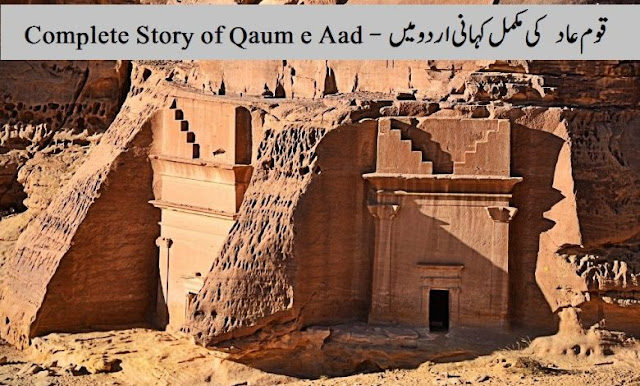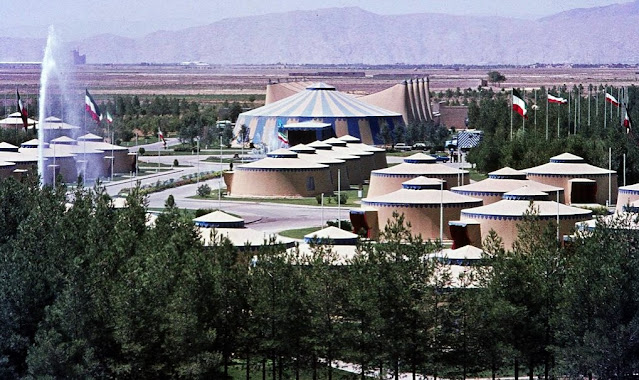According to the Qur’an, the Thamud were punished and destroyed by a soundwave. Thamud possessed excellent craftsmanship that they had carved their houses out of the dense rock of the mountains. Petra in Jordan has been declared to be one of the world wonders in 2007.
Madain Salih (Dedan) is in Saudi Arabia and is known in the European literature as Hegra derived from Al-Hijr. It was once inhabited by the Thamud or the Nabataeans. Petra (located in Jordan) being the capital of the Nabataean kingdom.
Location of Petra
Petra is an ancient city that lies in
present-day Jordan and dates back to the fourth century B.C. Ruins of the
once-great metropolis and trading center now serve as an important archeologic
site and tourist attraction.
Petra is located about 150 miles
south of both Jerusalem and Amman, the capital of Jordan, and about midway
between Damascus, Syria, and the Red Sea, making it ideally suited as a hub of
commerce in the area.
After the destruction of the Aad, the tribe
of Thamud succeeded them in power and glory. They also fell to
idol-worshipping. As their material wealth increased so, too, did their evil
ways while their virtue decreased. Their lands were fertile, and it gave them
abundant crops as well! But as their material wealth increased, so did their
evil ways!
Like the people of Aad, they erected huge buildings on the plains and hewed beautiful homes out of the hills. Tyranny and oppression became prevalent as evil men ruled the land.
Allah sent many prophets to various people
and nations. According to some Islamic traditions, the number is 124,000.
However, while these narrations aren’t authentic, we do know that there were
many prophets of Allah.
He
has mentioned 25 prophets in the Quran. Among them is Prophet Saleh, and his
story relates to the people of Thamud. The report refers to the story of the
she-camel, which was a gift from Allah for the people of Thamud.
Story
of prophet salih in Islam
Prophet Saleh, sometimes written as Salih,
was a descendant of the great prophet Nuh (May peace be upon him). He was sent
by Allah to the nation of Thamud who lived in Al Hijr, located in Arabia. The
nation over a few generations had matured and became very powerful, wealthy and
influential.
The Qur’an mentions how the society grew
very proud of their accomplishments and began building huge castles, palaces,
and other structures as status symbol of their power. This is mentioned in
Surah Ash Shura ayat 128-129:
“Do you construct on every elevation a sign
amusing yourselves? And take for yourselves palaces and fortresses that you may
abide eternally?”
They were given a
chance by Allah to turn back to Him especially knowing what had happened to the
people of Aad for their disobedience. The Qur’an mentions the warning from
Prophet Hud who said, “Will you not fear Allah?” (26:124).
They denied these warnings as obsession with
materialism took over. They turned away from the path of truth; the poor began
worshiping the rich who proclaimed themselves as Gods.
Prophet
Saleh was a man from a very high standing in society. He built a reputation of
respect and was wealthy himself. The People of Thamud held him in high regard
for his wisdom and virtue and were prepared to appoint him as their leader. It
was during this period that Allah bestowed Saleh with Prophethood.
Prophet Saleh
admonished his people, “O my people, worship Allah; you have no deity other
than Him. He has produced you from the earth and settled you in it. So ask
forgiveness of Him and then repent to Him. Indeed, my Lord is near and
responsive” (11:61).
Saleh continued to
urge the people to obey him and fear and worship Allah. But they replied, “O
Saleh, you were among us a man of promise before this.
Do you forbid us to
worship what our fathers worshipped? And
indeed we are in disquieting doubt about that to which you invite us.”
(11:62) However, few among the poor
followed and entered the fold of Islam while the majority rebuked Saleh. Some
called him a lunatic while others said he must be possessed.
As the
days passed, the Thamud feared that Prophet Saleh’s followers would increase in
number. In an attempt to put him off, they planned to ask Saleh for a miracle
proving that he was indeed the messenger of Allah.
People
of Thamud asked for a Miracle
They
intended to make this miracle impossible to be brought up. So the main leaders
of the Thamud sat down together and confronted Saleh. They pointed at a
particularly enormous rock and demanded Saleh to bring out from it a she camel
that was extremely tall, very woolly, and attractive and ten months pregnant!
They further stipulated that it should be able to produce milk for the entire
town.
Saleh was desperate
to bring his people to the path of Allah. So he pleaded with Allah to grant him
what the people had asked for. And there came the day when Saleh gathered his
people to witness the coming of the miracle.
Allah (SWT) created She-camel from the rock
Allah
ordered that very rock to split as under and from it emerged a red, gigantic,
ten month pregnant she-camel, much to the awe and amazement of the people.
It was a clear
evidence in their midst that a number of people declared their faith. However,
the vast majority remained untouched and pursued their disbelief, stating this
was nothing but pure magic.
The Qur’an simply states, “O my people, this
is the she-camel of Allah – [she is] to you a sign. So let her feed upon Allah
‘s earth and do not touch her with harm, or you will be taken by an impending
punishment.”)
The she-camel was
indeed a living miracle that every passing day people converted to Islam. The
disbelievers could not bear this. Eventually their hatred for Saleh was
diverted towards the she-camel.
The she-camel became the symbol for Saleh (AS) message. It
became the symbol of Allah (swt).
After three days, the
she-camel gave birth to a lovely young he-camel. The young camel always
followed his mother. It stayed behind its mother calmly, and she looked after
son fondly. Very soon, the she-camel and her son became symbols for affection
and mercy.
When the people of the tribe saw it, people
said "This is Saleh's she-camel"
Then the Prophet
Saleh (AS) said to his people "O my people worship Allah. There is no God
but him.This is a clear sign from your Lord. This she-camel is a sign for you.
So leave her to graze on Allah's earth. Be careful not to hurt it. If you do
that, then Allah will punish you."
Days passed, and the
she-camel grazed in the green pastures of 'Thamud. It ate the plants from the
valley, and drank water from the well.
The she-camel was so huge that it drank lots and lots of
water. And while it was drinking water from the well, no other animal or people
could go near the well. The she-camel nursed the newborn fondly. She gave him
her milk. When the people of 'Thamud saw the milk, their mouths watered.
They hurried to the Prophet
Saleh (AS).People said to Prophet Saleh (AS) "The camel's milk may be
blessed!"
People requested "The
baby camel is not going to have all of it, so please let us have some of the
she camel's milk."
The Prophet Saleh (AS) thought for a while,
and he said that they were allowed to have the milk of the camel, by Allah's
grace.
However he asked them
to share the water with the camel. He told them that one day they could have
the milk of the camel, while she drank water from the well. And the second day,
he told them to leave the milk for her child.
The people agreed to
the Prophets suggestion. The camel gave plenty of milk and it covered the needs
of the entire Thamud! At first the people were happy and content. But soon, the
disbelievers started raising their voices. They hated the Prophet Saleh (AS)
for turning people away from their idols. And their hatred now turned towards
the blessed she-camel!
Saleh
feared that the disbelievers would conspire against the she-camel and warned
them, “O my people! This she camel of Allah is a sign to you, leave her to feed
on Allah’s earth, and touch her not with evil lest a near torment will seize
you.” The Thamud initially allowed the
she-camel to graze on their land and drink freely from the common well but this
was short-lived.
It wasn’t long before Thamud became
disgruntled; the believers found their faith increasing while the disbelievers’
hatred intensified to a degree where they began plotting to kill the she camel.
People
of Thamud Killed She-Camel. And Allah Destroyed Them
With the support of all the disbelievers in town, nine men set out aiming to kill the she-camel. They watched her closely. As she approached to drink from the well one of the men shot her in the leg, thereby hindering her from escape. The others immediately sprang forward and put a sword through her body, killing her.
The townspeople saw
this as a clear victory and cheered loudly for the men. They went on to
slaughter the she-camel and eat her meat. When Saleh heard of this he hurried
to warn the people, but it was too late.
The people mocked him saying, “O Saleh,
bring us what you promise us, if you should be of the messengers.” Saleh
replied, “Enjoy yourselves in your homes for three days. That is a promise that
will not be denied.” (11:65)
The disbelievers taunted Saleh
and asked him to hasten the punishment. Prophet Saleh said “O my people, why
are you impatient for evil instead of good? Why do you not seek forgiveness of
Allah that you may receive mercy?” The people paid no heed.
They
were only infuriated and began plotting to kill Prophet Saleh.
The nine men gathered together and
discussed, “Take a mutual oath by Allah that we will kill him by night, he and
his family. Then we will say to his executor, ‘We did not witness the
destruction of his family, and indeed, we are truthful.” (27:49)
Meanwhile Allah had a plan for the people of
Thamud, “And they planned a plan, and We planned a plan, while they perceived
not” (27:50) so he instructed Saleh to gather his followers and leave town.
The people were only too happy to be rid of
him. They were unperturbed by Saleh’s warning. They believed their rock
fortresses would protect them from all disasters.
Three days after Salih’s warning, thunderbolts filled the air, followed by severe earthquakes which destroyed the entire tribe and its homeland.
The land was violently shaken, destroying all living
creatures in it. There was one terrific cry which had hardly ended when the
disbelievers of Salih’s people were struck dead, one and all, at the same time.
Neither their strong buildings nor their rock hewn homes could protect them.
The disbelievers of Thamud had no ally that
day. They had incurred the wrath of Allah which caused them to be destroyed
before they realized what was happening.
Meanwhile, Prophet Saleh and the believers
were saved by Allah’s grace. He returned to Al Hijr one day to witness the
destruction of his people and said with a heavy heart, “O my people, I had
certainly conveyed to you the message of my Lord and advised you, but you do
not like advisors.”
Prophet Saleh then migrated to
Palestine, where he lived until his death.
The End







































